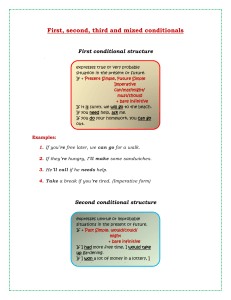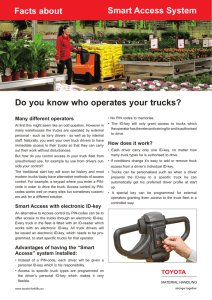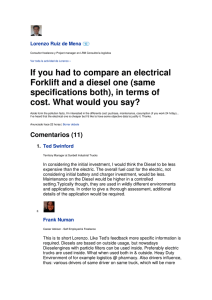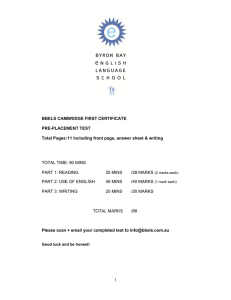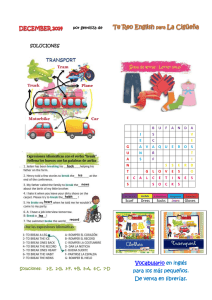Heavy Truck Maintenance: Issues & Analysis | Maritime Research
Anuncio
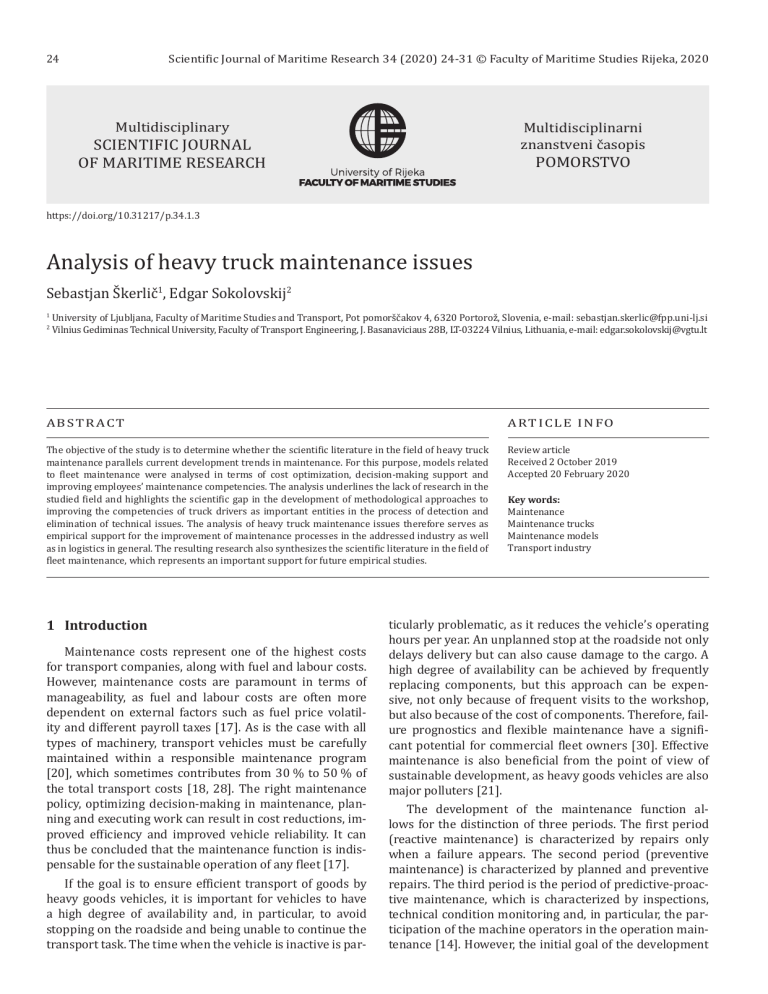
24 Scientific Journal of Maritime Research 34 (2020) 24-31 © Faculty of Maritime Studies Rijeka, 2020 Multidisciplinary Multidisciplinarni znanstveni časopis SCIENTIFIC JOURNAL OF MARITIME RESEARCH POMORSTVO https://doi.org/10.31217/p.34.1.3 Analysis of heavy truck maintenance issues Sebastjan Škerlič1, Edgar Sokolovskij2 1 2 University of Ljubljana, Faculty of Maritime Studies and Transport, Pot pomorščakov 4, 6320 Portorož, Slovenia, e-mail: sebastjan.skerlic@fpp.uni-lj.si Vilnius Gediminas Technical University, Faculty of Transport Engineering, J. Basanaviciaus 28B, LT-03224 Vilnius, Lithuania, e-mail: edgar.sokolovskij@vgtu.lt ABSTRACT The objective of the study is to determine whether the scientific literature in the field of heavy truck maintenance parallels current development trends in maintenance. For this purpose, models related to fleet maintenance were analysed in terms of cost optimization, decision-making support and improving employees’ maintenance competencies. The analysis underlines the lack of research in the studied field and highlights the scientific gap in the development of methodological approaches to improving the competencies of truck drivers as important entities in the process of detection and elimination of technical issues. The analysis of heavy truck maintenance issues therefore serves as empirical support for the improvement of maintenance processes in the addressed industry as well as in logistics in general. The resulting research also synthesizes the scientific literature in the field of fleet maintenance, which represents an important support for future empirical studies. 1 Introduction Maintenance costs represent one of the highest costs for transport companies, along with fuel and labour costs. However, maintenance costs are paramount in terms of manageability, as fuel and labour costs are often more dependent on external factors such as fuel price volatility and different payroll taxes [17]. As is the case with all types of machinery, transport vehicles must be carefully maintained within a responsible maintenance program [20], which sometimes contributes from 30 % to 50 % of the total transport costs [18, 28]. The right maintenance policy, optimizing decision-making in maintenance, planning and executing work can result in cost reductions, improved efficiency and improved vehicle reliability. It can thus be concluded that the maintenance function is indispensable for the sustainable operation of any fleet [17]. If the goal is to ensure efficient transport of goods by heavy goods vehicles, it is important for vehicles to have a high degree of availability and, in particular, to avoid stopping on the roadside and being unable to continue the transport task. The time when the vehicle is inactive is par- A RT I C L E I N F O Review article Received 2 October 2019 Accepted 20 February 2020 Key words: Maintenance Maintenance trucks Maintenance models Transport industry ticularly problematic, as it reduces the vehicle’s operating hours per year. An unplanned stop at the roadside not only delays delivery but can also cause damage to the cargo. A high degree of availability can be achieved by frequently replacing components, but this approach can be expensive, not only because of frequent visits to the workshop, but also because of the cost of components. Therefore, failure prognostics and flexible maintenance have a significant potential for commercial fleet owners [30]. Effective maintenance is also beneficial from the point of view of sustainable development, as heavy goods vehicles are also major polluters [21]. The development of the maintenance function allows for the distinction of three periods. The first period (reactive maintenance) is characterized by repairs only when a failure appears. The second period (preventive maintenance) is characterized by planned and preventive repairs. The third period is the period of predictive-proactive maintenance, which is characterized by inspections, technical condition monitoring and, in particular, the participation of the machine operators in the operation maintenance [14]. However, the initial goal of the development S. Škerlič et al. / Scientific Journal of Maritime Research 34 (2020) 24-31 of different maintenance strategies was to provide support to production processes in companies, and less so to participants in the transport industry. This is surprising, especially considering the large number of transport companies in different countries of Europe and the USA. The maintenance process in the transport sector involves various actors, such as company management, the maintenance function and truck drivers. The objective of the study is thus to determine whether the scientific literature in the field of heavy truck maintenance parallels current development trends in maintenance. To this end, various cost, analytical and simulation models related to fleet maintenance in transport companies were analysed. Gaps in the field of maintenance research in road transport industry are highlighted based on an analysis of the scientific literature. The analysis of maintenance issues therefore serves as empirical support for the improvement of maintenance processes in the addressed sector as well as in logistics in general. The resulting research also synthesizes the scientific literature in the field of heavy truck maintenance, which represents an important support for future empirical studies. The rest of the article is structured as follows: The Literature Review in the second chapter details the evolution of the maintenance function over different time periods. The chapter continues with a focus on the issues concerning the maintenance of heavy trucks. The third chapter is dedicated to the research methods used, followed by the results of the study. The final chapter offers a discussion of the results and the conclusion, highlighting the key factors that influence further maintenance research in the addressed field. 2 Literature review: Development of the modern maintenance function Maintenance targets can be considered according to the Max/Min – principle. Maximizing the maintenance output, which is corresponding to technical equipment efficiency by minimizing all efficiency loss factors. The second portion of maintenance targets is minimizing the input to maintenance, which can be expressed for example in manpower, tools, systems, processes, cost, knowledge etc. [27]. The increasing contribution of direct maintenance costs to a company’s variable costs requires an intense search for opportunities to reduce these costs. Numerous indices show that not only the maintenance of machinery, but also the absolute and relative costs of such maintenance are becoming increasingly important [14]. Effective maintenance also has a significant impact on safety, especially in road traffic, which is subject to frequent accidents between individual participants [24, 26, 32]. In general, the maintenance function has gone through three different developmental stages. Until the Second World War, the reactive approach was prevalent, which meant that repair actions were only required when failure 25 occurred. After the war, the reactive approach turned into a preventive one: maintenance was planned for a certain period, according to the time of use, to prevent possible failures [1]. Many machines are already subject to numerous controls and their design has become increasingly complex. The impact of the defective device on production continuity has also increased. The question of whether a malfunction could be prevented and how to do it has become salient. This area is now regulated, thanks to the concept of planned preventive repairs. However, the strategy for maintaining preventive operations is unsuccessful when several failures occur at an early stage of use. According to Moubray [19], the above mentioned fact and the further development of industrial production brought on a new approach to the maintenance of operations, the most important element of which was to ensure the smooth operation of machines and devices throughout their utilization time. The above changes resulted in new concepts for the maintenance of machines and devices. In the classical approaches, the emphasis was on the importance of inspections, while in the new ones attention has also been drawn to [14]: auxiliary tools for decision making (risk assessment, models of failure intensity and analysis of failure results); new techniques of operation maintenance (condition monitoring) and, above all, modified understanding of organisation leading to participation and team work. Figure 1 shows the evolution of the maintenance function over different periods in terms of relative maintenance costs. If the reactive maintenance approach from the first period had persisted until the present day, maintenance costs would be dramatically higher. Due to the preventive maintenance mindset, maintenance costs experienced an increase during the second period, but from today’s standpoint, they would actually have decreased, compared to the first period. The development of a new maintenance mindset, which is characteristic of the third development period, results in a significant reduction in maintenance costs. The most important concepts that were developed during the third period are RCM (reliability centered maintenance) and TPM (total productive maintenance). Those systems are based on a detailed knowledge about the condition of the machinery, its failures and risks [29]. The main objectives of RCM are to reduce maintenance costs and increase the reliability and safety of the system under review. A maintenance concept can be defined as the set of various maintenance interventions, which can be corrective, preventive, condition based, etc. [10]. The RCM concept might be characterized as organized engineering common sense. These methodologies have four unique features [2, 10]: preserve functions, identify failure modes that can defeat the functions, prioritize function need (via the failure modes), select only applicable and effective preventive maintenance tasks. The RCM process entails asking seven basic questions about the function, asset or system under review, as follows [10, 19]: What are the function and associated performance standards of the asset in its present operating context? In 26 Source: [14] S. Škerlič et al. / Scientific Journal of Maritime Research 34 (2020) 24-31 Figure 1 The maintenance function over different periods in terms of relative maintenance costs what ways does it fail to fulfil its functions? What causes a functional failure? What happens when a failure occurs? In what way does each failure matter? What can we do to predict or prevent a failure? What should be done if a suitable proactive task cannot be found? Source: [14] The general layout of the procedure in the RCM method can be seen in Figure 2. A proper understanding of the RCM implementation steps contributes to the improvement of operation maintenance efficiency. Success, however, is only achieved if enough attention is devoted to Figure 2 General layout of the procedure in the RCM method S. Škerlič et al. / Scientific Journal of Maritime Research 34 (2020) 24-31 planning, to the determination of how and who performs the analyses, to audits and team work. Particular importance is attributed to team work in the implementation of the RCM. This is because, in practice, the operation maintenance specialists cannot answer the seven RCM questions on their own, particularly when the questions relate to the functions, their fulfilment, the effects and the results of failures. That is why operation maintenance requirements should be checked by small teams composed of operators of the machines and devices. Team work allows one to learn the knowledge and opinions of each member, but also to acquire vast knowledge concerning the functioning of machines and devices. [14]. Just like RCM, TPM (total productive maintenance) is an important concept in modern maintenance. TPM is part of a Japanese philosophy that was developed based on productive maintenance concepts and methodologies. The concept was first introduced by Nippon Denso, a Japanese supplier of the Toyota Motor Company, in 1971. TPM is an innovative approach to achieve the goal of zero breakdowns, zero irregularities and zero defects and zero accidents [11]. The objective of TPM is to increase the availability/ efficiency of existing equipment by seeking to reduce the input (improving and maintaining equipment at the optimum level to reduce costs over its life cycle) and investing in human resources, resulting in better use of machines Source: [7] 27 [7]. Legutko [14] also emphasizes that the use of the TPM concept ensures higher equipment efficiency and emphasizes the following advantages: a thorough preventive maintenance system is in place for the entire life of the equipment; it is implemented by various departments within the company; every single employee is engaged, from top management to store employees, and TPM is based on the promotion of PM (preventive maintenance) through “motivation management”, which involves small group activities. TPM therefore provides a synergistic link between all organizational functions, especially between production and maintenance. Its objective is to continually improve product quality, as well as operational efficiency and system performance assurance. TPM efficiency depends on both production and maintenance activities. The key pillars of TPM are shown in Figure 3 [7]. The transfer of the competencies of the maintenance staff to the production function of the company is essential for the effective implementation and application of the TPM concept. This means that in addition to their production tasks, operators also have important maintenance tasks, such as: maintaining basic equipment conditions (cleaning, lubrication, etc.); maintaining operating conditions (proper operation and visual inspection); detection of deterioration, mainly by visual inspection and early identification of signs of malfunctioning and improving the skills associated with performing minor repairs. These Figure 3 Key pillars of TPM S. Škerlič et al. / Scientific Journal of Maritime Research 34 (2020) 24-31 28 activities add to the existing responsibilities of machine operators. On the other hand, maintenance personnel should do the following: provide technical support for the activities of operators on the machine; thoroughly repair any deteriorations with the use of inspections, provide monitoring and overhaul; clarify operational standards by monitoring design flaws and applying appropriate improvements and improve maintenance skills [7]. 3 Methodology The scientific literature search was conducted in the Clarivate Analytics database, Web of Science Core Collection in May 2019. The terms “maintenance fleet” and “maintenance trucks” were searched for the period between the year 1980 and May 2019. Out of 680 hits, 507 were articles, 215 proceedings papers, 8 reviews, 2 meeting abstracts and 2 book chapters. An analysis of the scientific works dealing exclusively with the field of heavy truck maintenance with the development of modern methodological approaches was carried out. Due to the narrow field of research, the field of analysis was reduced to 11 scientific works, of which 9 are scientific articles and two proceedings papers. Eight scientific articles are part of Journal Citation Reports indexed in Scopus (Elsevier’s abstract and citation database) and the Web of Science Core Collection. Two proceedings papers are part of the Web of Science Core Collection and one scientific article is indexed in Scopus and in Web of Science. 4 Results The analysed scientific works include various cost, analytical and simulation models that relate to the field of heavy truck maintenance. Table 1 [12, 15, 23, 9, 18, 13, 25, 8, 6, 16, 5] provides an overview and synthesis of the scientific literature related to the development of maintenance models from the following aspects: costs, organization and human resources. The objective of the analysis is to determine whether the scientific literature in the field of truck maintenance parallels current development trends in maintenance. Eleven scientific articles were published in the period between the year 1980 and May 2019. The authors of eight of those scientific articles are concerned with the cost optimization of maintenance, while nine scientific articles deal with improving the organization of maintenance or decision-making support and only one article focuses on the field of human resource management. Table 1 An overview of the scientific literature in the field of truck maintenance model development Author Haghani & Shafahi, 2002 Lhorente et al., 2004 Okulewicz & Salamonowicz, 2008 Fornasiero et al., 2012 Model description A model for scheduling bus maintenance activities A model for optimal armature maintenance in electric haul truck wheel motors Model of preventive maintenance for a vehicle fleet A cost evaluation model for trucks maintenance planning Application of optimal maintenance methods for Moniri Morad et al., reduction of occurrence of sudden failures and 2014 equipment Model of optimal preventive maintenance for a Husniah et al., 2015 two-dimensional lease contract of a fleet of dump trucks Modeling Failure and Maintenance Effects of a Said & Taghipour, System Subject to Multiple Preventive Maintenance 2016 Types Lean model for technical maintenance of technical Epler et al., 2017 systems for special purposes - military combat vehicles Chaowasakoo et al., A model of effective scheduled maintenance for 2018 different truck age levels Linneusson et al., A system dynamics model 2018 Optimal preventive maintenance model based on Barde et al., 2019 reinforcement learning of a fleet of military trucks Source: Authors Orientation Costs Human resources Organisation – DS NO NO YES YES NO NO YES YES NO YES NO YES YES NO NO NO NO YES YES YES YES YES NO YES YES YES NO NO NO NO YES YES YES S. Škerlič et al. / Scientific Journal of Maritime Research 34 (2020) 24-31 Source: Authors 29 Figure 4 Combination of maintenance models A detailed analysis of the combination of individual maintenance models shows the following results (Figure 4): Out of n = 11 scientific articles, 5 articles address the costs of maintenance and the organization of maintenance through developed models; 3 scientific articles deal exclusively with maintenance organization; two articles address the optimization of maintenance costs and only one article deals entirely with costs, organization, and human resources in connection with maintenance. 5 Discussion and conclusions Initially, the development of various maintenance strategies was aimed at supporting the manufacturing processes in companies, but they have proven to be suitable for use in the transport industry as well. However, what can be generalized on the basis of the analysis and synthesis of the scientific literature is that research in the field of the development of heavy truck maintenance is not dealing in sufficient detail with the staff responsible for performing maintenance. This is also clearly evidenced by the fact that only one work of scientific literature addresses the subject of human resources improvement. Based on current maintenance guidelines in the manufacturing industry, it has been clear for several years that maintenance competencies are being added to the competencies of machine operators. It would be expected for the scientific literature in the field of heavy truck maintenance in the transport industry to also be focused on improving the competencies of drivers, as they interact with the truck on a daily basis. It can be argued that they interact with the truck even more than the operators interact with the machine, since a driver working in international road transport spends five days a week in the truck on average and depends heavily on the technical flawlessness of the vehicle. The impor- tance of the truck driver in the maintenance process is also evident from the analysis of the US and EU Employment Service portal [4, 31], which outlines the driver’s tasks in terms of truck maintenance. The truck driver must therefore be trained to work within three mental approaches to maintenance, namely: the ability to repair minor defects (changing tires, lights); preventive maintenance (inspection of tires, lights, brakes, oil and water) and maintenance planning (cooperation and providing suggestions regarding corrective actions at company level). Based on the analysis, it can be concluded that the modern methodological approaches in the maintenance of heavy trucks in the transport industry are mostly focused on the organization of maintenance or support in decision-making, as well as cost optimization of the maintenance function. The only exception is one scientific work [8] that focuses on all modern aspects of managing the maintenance function. Thus, the basic findings of the study are: - There is a lack of scientific research that deals with truck maintenance. Of the 680 hits, only 11 scientific articles address the subject of maintenance improvements in the transportation industry through the development of different methodological approaches. - Out of the 11 scientific papers analysed, only one article addresses modern truck maintenance guidelines. This is the only article where, in addition to optimizing maintenance costs and improving maintenance decisions, the human resources aspect is taken into account. - The role of the truck driver as an important entity in the process of detecting and correcting technical issues in the truck has not been addressed. A conclusion can be drawn from this, which is that the development of 30 S. Škerlič et al. / Scientific Journal of Maritime Research 34 (2020) 24-31 driver competencies is not aligned with current trends in maintenance that are characteristic of the field of manufacturing.And it is precisely the efficiency of the maintenance process in companies that requires competent and maintenance-conscious employees. Their knowledge, skills and ability to respond to unexpected situations largely determine the effectiveness of the technical infrastructure in the company [3]. Oke et al. [22] also point out that a highly skilled personnel represents an important strategic direction for maintenance in companies. Precisely because of the lack of research in the analysed field, it is impossible to reach any conclusions on how to improve maintenance in terms of competency development in both drivers and maintenance personnel. Due to the important role of drivers in the efficiency of the maintenance function in a company, the results highlight the research gap in the development of the maintenance function in transport companies so far. The analysis of heavy truck maintenance issues in the transport sector therefore serves as empirical support for the improvement of maintenance processes in the addressed sector as well as in logistics in general. The resulting research also synthesizes the scientific literature in the field of heavy truck maintenance, which represents an important support for future empirical studies. An analysis and synthesis of scientific works related to the field of maintenance in the road transport industry was conducted. Future studies could produce statistical surveys that relate to the organization and management of maintenance functions in transport companies in practice. References [1] Andersson, R., Manfredsson, P., Lantz, B. (2015) Total productive maintenance in support processes: an enabler for operation excellence. Total Quality Management & Business Excellence, 26(9-10), pp. 1042–1055. [2] Anthony, M.S., Glenn, R.H. (2003) RCM-A Proven Approach, RCM-Gateway to world class maintenance, 1st Edition. Butterworth-Heinemann. [3] Antosz, K. (2018) Maintenance – identification and analysis of the competency gap. Eksploatacja i Niezawodnosc – Maintenance and Reliability, 20(3), pp. 484–494, [4] Bureau of Labor Statistics, U.S. Department of Labor, Occupational Outlook Handbook, Heavy and Tractor-trailer Truck Drivers, Retrived from: https://www.bls.gov/ooh/ transportation-and-material-moving/heavy-and-tractortrailer-truck-drivers.htm Accessed: 07/07/2019. [5] Barde, S.R.A., Yacout, S., Shin, H. (2019) Optimal preventive maintenance policy based on reinforcement learning of a fleet of military trucks. Journal of Intelligent Manufacturing, 30, pp. 147–161. https://doi.org/10.1007/s10845-0161237-7. [6] Chaowasakoo, P., Seppälä, H., Koivo, H. (2018) Age-based maintenance for a fleet of haul trucks. Journal of Quality in Maintenance Engineering, 24(4), pp. 511–528. https://doi. org/10.1108/JQME-03-2017-0016. [7] Chan, F.T.S., Lau H.C.W., Ip, R.W.L., Chan, H.K., Kong, S. (2005) Implementation of total productive maintenance: A case study. International Journal of Production Economics, 95(1), pp. 71–94. [8] Epler, I., Sokolović, V., Milenkov, M., Bukvić, M. (2017) Application of lean tools for improved effectiveness in maintenance of technical systems for special purposes. Eksploatacja i Niezawodnosc – Maintenance and Reliability, 19(4), pp. 615–623, http://dx.doi.org/10.17531/ein.2017. 4.16. [9] Fornasiero, R., Zangiacomi, A., Sorlini, M. (2012) A cost evaluation approach for trucks maintenance planning, Production Planning & Control. 23(2-3), pp. 171–182, doi: 10.1080/09537287.2011.591641. [10] Gania, I.P., Fertsch, M.K., Jayathilaka, K.R.K. (2017) Reliability Centered Maintenance Framework for Manufacturing and Service Company: Functional Oriented. 24th International Conference on Production Research (ICPR 2017), pp. 721–725. [11] Habidin, N., Hashim, S., Fuzi, N., Salleh, M. (2018) Total productive maintenance, kaizen event, and performance. International Journal of Quality & Reliability Management, 35(9), pp. 1853-1867. https://doi.org/10.1108/IJQRM-11- 20170234. [12] Haghani, A., Shafahi, Y. (2002) Bus maintenance systems and maintenance scheduling: model formulations and solutions. Transportation Research Part A: Policy and Practice, 36(5), pp. 453–482. [13] Husniah, H., Pasaribu, U.S., Iskandar, B.P. (2015) Optimal Preventive Maintenance for a Fleet of Dump Trucks with Two-Dimensional Lease Contract. 2015 IEEE International Conference on Industrial Engineering and Engineering Management (IEEM), pp. 1067–1071. [14] Legutko, S. (2009) Development trends in machines operation maintenance. Eksploatacja i Niezawodnosc – Maintenance and Reliability, 42(2), pp. 8–16. [15] Lhorente, B., Lugtigheid, D., Knights, P.F., Santana, A. (2004) A model for optimal armature maintenance in electric haul truck wheel motors: a case study. Reliability Engineering and System Safety, 84(2), pp. 209–218, https://doi.org/ 10.1016/j.ress.2003.10.016. [16] Linneusson, G., Ng, H.C., Amos, A.T. (2018) Towards strategic development of maintenance and its effects on production performance by using system dynamics in the automotive industry. International Journal of Production Economics, 200, pp. 151–169. [17] Macián, V., Tormos, B., Herrero, J. (2019) Maintenance management balanced scorecard approach for urban transport fleets. Eksploatacja i Niezawodnosc – Maintenance and Reliability, 21(2), pp. 226–236. http://dx.doi.org/10.17531/ ein.2019.2.6. [18] Moniri Morad, A., Pourgol-Mohammad, M., Sattarvand, J. (2014) Application of reliability-centered maintenance for productivity improvement of open pit mining equipment: Case study of Sungun Copper Mine. Journal of Central South University of Technology, 21(6), pp. 2372–2382. doi: 10.1007/s11771-014-2190-2. [19] Moubray J., (1997) Introduction to Reliability-centered maintenance, Reliability-centered maintenance, 2nd Edition, 6–21. [20] Muha, R. (2009) Influence of Sustainable Development Guidelines on Dangerous Goods Haulers. Promet – Traffic&Transportation, 21(6), pp. 425–432. S. Škerlič et al. / Scientific Journal of Maritime Research 34 (2020) 24-31 [21] Muha, R., Perosa, A. (2018) Energy Consumption And Carbon Footprint Of An Electric Vehicle And A Vehicle With An Internal Combustion Engine. Transport Problems, 13(2), pp. 49–58. [22] Oke, S.A., Bamigbaiye, A., Oyedokun, O.I. (2006). A mathematical model for evaluating accelerated wear due to inefficient maintenance. Transport, 21(2), pp. 105–111. [23] Okulewicz, J., Salamonowicz, T. (2008) Modelling preventive maintenance for a vehicle fleet. Eksploatacja i Niezawodnosc – Maintenance and Reliability, 37(1), pp. 67–71. [24] Prentkovskis, O., Sokolovskij, E., Bartulis, V. (2010) Investigating traffic accidents: A collision of two motor vehicles. Transport, 25(2), pp. 105–115. [25] Said, U., Taghipour S. (2016) Modeling failure and maintenance effects of a system subject to multiple preventive maintenance types. Annual Reliability and Maintainability Symposium (RAMS), Tucson, AZ, 2016, pp. 1–7. doi: 10.1109/RAMS.2016.7448007. [26] Sokolovskij, E., Prentkovskis, O. (2013) Investigating traffic accidents: the interaction between a motor vehicle and a pedestrian. Transport, 28(3), pp. 302–312. 31 [27] Spork, N. (2007) The way forward excellence in maintenance. Eksploatacja i Niezawodnosc – Maintenance and Reliability, 4(36), pp. 77–78. [28] Topal, E., Ramazan, S. (2010) A new MIP model for mine equipment scheduling by minimizing maintenance cost. European Journal of Operational Research, 207(2), pp. 1065– 1071. [29] Vorkapić, A., Kralj, P., Martinović, D. (2017) The analysis of the maintenance systems of a LPG carrier’s liquefaction system main components. Pomorstvo, 31(1), pp. 3–9. https:// doi.org/10.31217/p.31.1.2. [30] Voronov, S., Frisk E., Krysander, M. (2018). Data-Driven Battery Lifetime Prediction and Confidence Estimation for Heavy-Duty Trucks. IEEE Transactions on Reliability, 67(2), pp. 1–17. [31] Zavod RS za zaposlovanje. Accessed: 07/07/2019 Retrived from: https://www.ess.gov.si/ncips/cips/opisi_poklicev/ opis_poklica?Kljuc=2215&Filter= [32] Žuraulis, V., Levulytė, L., Sokolovskij, E. (2014). The impact of road roughness on the duration of contact between a vehicle wheel and road surface. Transport, 29(4), pp. 431–439.
